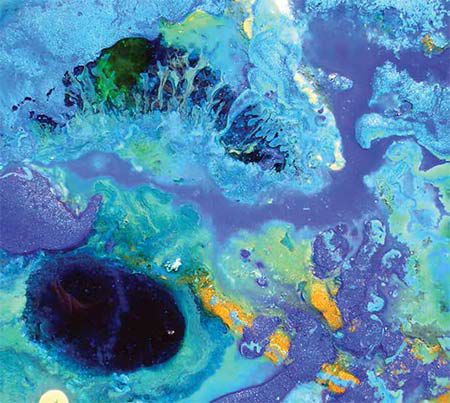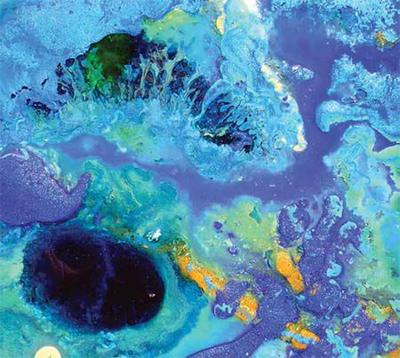100 years ago, when San Diego was little more than a sandy spot on a map, the Panama–California International Exposition came to Balboa Park, bringing with it a lasting esteem for the arts. The Exposition showcased works from local, national and international artists and established San Diego as a mecca for the craft. As San Diego grew and expanded her cultural horizons, so did her art. People of all backgrounds, races, and cultures flocked to San Diego, bringing their arts and traditional crafts with them and expanding the definition of art in our great city. Traditional displays of European paintings and sculptures displayed side–by–side with the textiles of India and the intricate pottery of Africa. All art, all San Diego. Our historical devotion to art continues today, from the watercolors displayed in the San Diego Museum of Art, to the murals sprayed across our cityscapes, to the works seen on our own pages in the annual...FINE Magazine Art Issue!
Yanya Morton
A former set painter in Vancouver’s film and television industry and the daughter of bohemian parents, Yanya Morton’s love of art and fashion was instilled in her at a young age. She was encouraged to explore and nurture her creative interests through the experience of travel and often finds inspiration in faraway exotic locations and submersing herself in their cultures. After two years of formal training and years in the film industry, the 1990’s became a time of rebirth in her career as an artist.

Yanya Morton artwork
Art has always offered the ultimate channel for meditation and self–expression. The idea of creating art that inspires, evokes thought and emotion and often heals is the ultimate goal for any artist. Yanya’s many interests are expressed through her diverse body of work, though each series is different in application and reflects the artist’s state of mind at that particular moment in time. Each series rarely has a definitive end, as Yanya has a tendency to revisit and explore other aspects of those earlier series with increased depth and intensity in her projection of attitude. Her earlier works concentrated on the nurturing of purities of Nature and celebrating a sense of innocence (for example, landscapes and flowers). As she progressed throughout her career, the complexities of her life and experiences have become more prevalent in her work. Her knowledge of different religions and environmental, social and political issues have become a driving force in her artwork over the last few years.
Her incorporation of collage of text and mixed media has allowed Yanya to delve into these issues with greater complexity and tenacity. The limitation of solely painting on canvas has presented the artist with a new sense of curiosity in her ability to create art in the third dimension. Whereas traditional sculpture would have been the first thing to consider, unconventional applications for expression are ultimately far more appealing. Finding a muse in mannequins is bound to spark exceptional visual experiences.

Yanya Morton
Yanya’s fascination with the relevance and influence mannequins have had on social history has inspired her recent work. The French meaning of mannequin can be translated as "artist’s jointed model," originating from the Flemish manneken or "little man, figurine." Mannequins first appeared in the 1800s in Paris. The shift from their originally designed body types, overly sexualized and faceless, changed to more futuristic models, lacking any discernible physical characteristics, including being headless. They began to assume a variety of postures and attitudes, which developed into a more disgusting trend of headless bodies, eggheads or white homogenized clones which took mannequins outside the conventional reality they had possessed up to that point. The traditional waspy and girdled portrayals shifted to appearing more surreal.
Salvador Dali (1904-1989), in his mannequin art display "The Water Taxi" at the 1938 International Exposition of Surrealism in Paris, created a new stage for mannequins. Another artist, Andy Warhol, who began his career as a window dresser, broke the mold as an innovative artist. Both artists crossed over from what was considered low art (window dressing) to high art (fine art), which reflected and influenced the cultural mindset of the ‘80s. Author Frank Baum, who also worked as a window dresser, is most famous for writing The Wizard of Oz, but he also penned an intriguing book titled Aunt Jane’s Nieces at Work about mannequins and how they reflected importance in the merchandising industry. He was an advocate of the innovative use of mannequins to create an alluring romance between merchandise and merchandising.
Yanya’s portrayal of mannequins as an art form arose from her fascination with and attuned sensitivity to the fashion world, coupled with her desire to express her understanding of the people and the plethora of unsettling representations. Their non–consumerist functions are another aspect she finds appealing. Mannequin’s idealized bodies have always given shape to our materialized fantasies, since the time of ancient Egypt. For example, as a result of the discovery of King Tut’s tomb in 1922, archeologists found iconic mannequins used to display his prized jewelry and clothing. Mannequins, throughout history, have embodied a strange blend of adoration, discomfort and, in some sense, abject terror.
During the Industrial Revolution, mannequins were made of wicker and papier–mČché but proved to be clumsy. In later years, they became heavier, made from wood, iron and wax.
With the onset of WWI, there was a demand for practicality, requiring a relaxed appearance, movable limbs and more realistic variations. During the 1920s, there arose a trend of gender–bending modernism, where the concept of the normal straight–laced woman was rejected and replaced by the boyish and androgynous flapper, emulating the transition of preference for a more unconventional lifestyle. Simultaneously, they revealed the influence of Art Deco and Art Nouveau movements, acknowledging geometric renditions of the human form. In the 1930s, where there existed such a gap between wealth and poverty brought by the great depression, some mannequins were designed to be more conservative, while others had more glamorous features such as high cheekbones and oval faces with a wider variety of poses and expressions.
The 1940s brought taxes and rationing, which evoked a somber expression displaying a sense of patriotic duty. From 1950 through 1960, there exploded upon the mannequin scene a burgeoning sense of more accentuated breasts and the Barbie image of the perfect hourglass figure, emulating Marilyn Monroe. In 1959, the American toy company Mattel manufactured the classic Barbie doll, selling 3 dolls per second. She and her counterpart Ken are still highly popular collectable toys.
During the ‘60s, mannequins were influenced by supermodels and constructed of super light materials. The ‘60s embodied the changing beauty standards of the sexual revolution but still rendered the shape and size of the average consumer. However, this period highlights the "supermodel" era, where stick thin "Twiggy" reigned supreme. During the ‘70s, faceless clones were the standard and were typically black, white or grey in color. By the ‘80s, society emulated the toned bodies of Jane Fonda and Richard Simmons; dressing like a tennis player or workout maven was considered cool. It was the arrival of velour sweat pants, leg warmers and Nike brand clothing. The ‘90s brought on the "heroin–chick" trend in mannequins, which were very toned but stick–thin, bordering on anorexic. From 2000 to today it’s a moot question whether mannequins are a case of art imitating life or a case of life imitating art.
The transformation has dramatically evolved for both the woman personified and the mannequin. They have changed and adapted to our modern time. For some people, nude mannequins seem sad and creepy. A nude mannequin does not ride on the merry–go–round of materialistic acquisition, seeming to serve no function other than to allude to the inherent purposelessness which consumerism imputes to real people who don’t, can’t or won’t fritter away their money. For the artist, a nude mannequin is a muse with endless possibilities and equates an empty canvas where the borders between low art and high art are defined.
The power of mannequins and the fantasy worlds they inhabit will continue to hold strong as they reject conventional and cultural attitudes, reinforcing social norms and ideals for years to come.
Dawn Hough Sebaugh
Dawn Hough Sebaugh was born in Mooresville, North Carolina and currently lives in the San Diego, California area. She received a BA in Marketing from Pfeiffer College in North Carolina and a Degree in Color and Design from Parson’s School of Design in New York. She also attended fine arts programs at Denver University in Colorado. Dawn began her career over two decades ago. She also is the founder/artist of Mara Dawn Studios and has participated in numerous gallery shows since the late 80’s.

Dawn Hough Sebaugh painting
She has also donated a number of her paintings for private charities including but not limited to the Sherman Oaks Burn Center (children’s wing) - Los Angeles California, UNICEF, Global Giving, Rescue Task Force - San Diego California, Artists With Brain Injuries - Los Angeles California, The Fund For Women Artists - Florence Massachusetts, Burn Survivors Throughout The World Inc. - Sarasota Florida, Mended Little Hearts - Dallas Texas, Sunflower, Doctors without Borders, Galapagos Conservancy, Association of the Hole in the Wall Camps - New Haven Connecticut, Save the Dalmatians and Others Canine Rescue Inc. - Gardena, California, USO Council of San Diego California, Autism Research Institute - San Diego California, American Red Cross Alabama Gulf Coast Chapter - Mobile Alabama, Susan G Komen 3 Day for the Cure - San Diego California and the St. Germaine Auxiliary for the Child Abuse Foundation of San Diego California. For more information, please visit dawnsebaugh.com
List of Publications:
2015 - Published in FINE Magazine February
2014 - La Jolla Art and Wine Festival - Juried Show - Won First Place
2014 - Photo credits in FINE Magazine November Issue
2014 - Published in and on the COVER of FINE Magazine October Issue

Dawn Hough Sebaugh
2014 - "Midsummer Night’s Dream" Art Show Juried Artist
2014 - Judge - Annual Congressional Art Competition
2014 - Visual Arts Chair - The heART of Mt. Helix
2014 - "New Beginnings" Solo Art Show - La Jolla
2013 - Chosen for Director’s Highlight RAWards San Diego
2013 - La Jolla Art & Wine Festival Juried Artist
2013 - Published in FINE Magazine Oct Issue
2013 - Senate’s 2013-2014 California Contemporary Art Collection
Exhibit at the State Capitol chosen by Senator Joel Anderson - Sacramento, CA
2013 - San Diego Fair juried exhibit June, July - Del Mar, CA
2013 - Graffiti Beach Art Show - San Diego, CA
2012 - Provocations Art Show - San Diego, CA
2012 - Artist of the Year Finalist RAWards - San Diego, CA
2012 - Solo Art Show - Main Street 5 Gallery -El Cajon, CA
2011 - Solo Art Show - O’Dunn Fine Art - La Mesa, CA
2012 - Herrick Library - 4 month exhibit - La Mesa, CA
2006 - Published in Nikki Style Magazine February, March and April - New York, NY
2004 - Self-published Abstract Art Book
1999-2000 - Past President - San Diego County Federation of Republican Women










(0) comments
We welcome your comments
Log In
Post a comment as Guest
Keep it Clean. Please avoid obscene, vulgar, lewd, racist or sexually-oriented language.
PLEASE TURN OFF YOUR CAPS LOCK.
Don't Threaten. Threats of harming another person will not be tolerated.
Be Truthful. Don't knowingly lie about anyone or anything.
Be Nice. No racism, sexism or any sort of -ism that is degrading to another person.
Be Proactive. Use the 'Report' link on each comment to let us know of abusive posts.
Share with Us. We'd love to hear eyewitness accounts, the history behind an article.